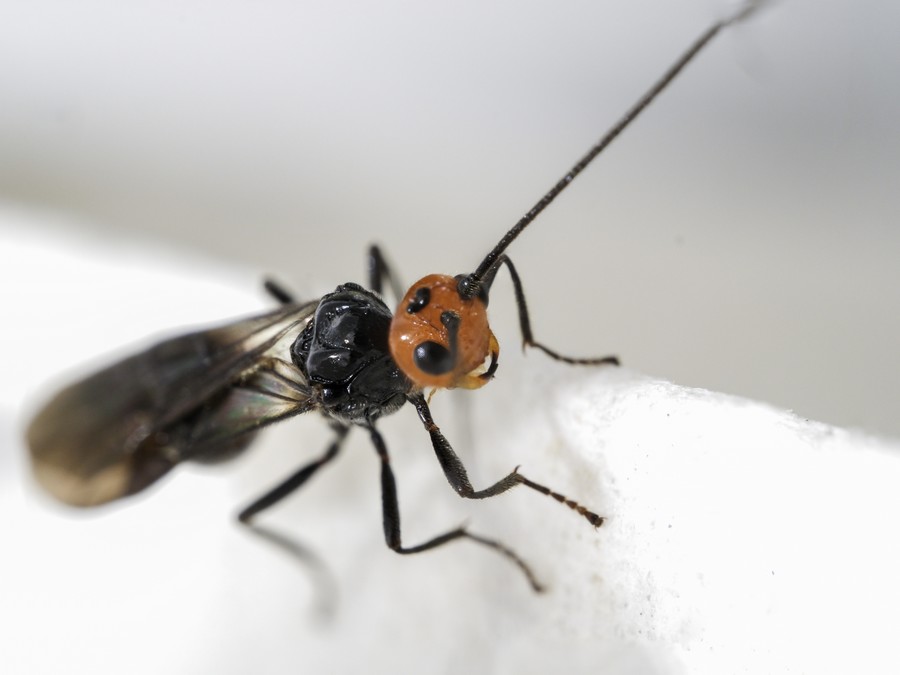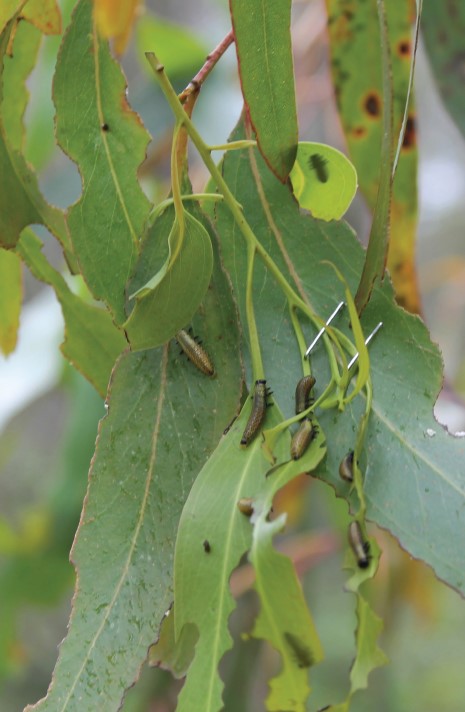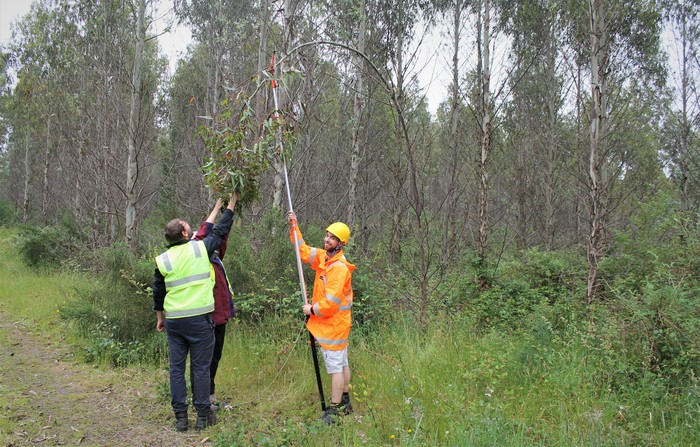Harnessing the power in nature to combat pests
After more than 10 years of research, a new biocontrol tool has been released to help combat a beetle destroying valuable Eucalypt plantation forests in New Zealand, highlighting that the solutions can often be found in nature.

The value of Eucalypts
Forestry and wood products are a big earner for New Zealand – $6.6 billion in 2022 to be exact. Much of this comes from radiata pine, but a small yet important part of New Zealand’s diversified forestry industry are Eucalypts.
Eucalypts are highly valued for pulp and paper, with additional benefits in farm forestry, shelter trees, soil erosion, carbon sequestration and amenity planting, as well as a growing resource for naturally durable wood.
The most common species, Eucalyptus nitens, packs a particularly weighty plantation punch by supporting our primary export industry.
How so? This fast-growing hardwood species’ short-fibre pulp has valuable characteristics which help create rigid cardboard packaging, which the export industry, particularly fresh produce, relies on to store and ship products around the world.
Yet these small but mighty plantation forests have been under attack since the introduction of the Eucalyptus tortoise beetle (Paropsis charybdis) from Australia more than 100 years ago.
The beetles cause serious damage, feeding on foliage and significantly reducing tree growth. The cumulative effect can also cause trees to die completely.
Scientists have unleashed a torrent of revenge upon this pest starting as far back as the 1950s but haven’t managed to eradicate it or fully prevent the damage it causes.
Biocontrols can be risky, but the cost benefits when it works is huge – 100 to one. And when it works, it should work forever. - Dr Toni Withers
The latest in protection
Recently, however, there has been a breakthrough with the introduction of a biological control agent into New Zealand from Tasmania, Australia to control the larvae of the Eucalyptus tortoise beetle – in the form of a small wasp.
A natural predator of the beetle, this parasitoid wasp (Eadya daenerys – and yes, this particular sub species was lovingly named by a Game of Thrones enthusiast, after the mother of dragons) was released into Eucalyptus plantation forests in December 2022 and January 2023 at sites in the Central North Island and Southland.
Releasing the wasps has been over a decade in the making, overcoming numerous scientific hurdles and setbacks. Turns out they have proven much more challenging to rear than the beetle they attack.

What is a parasitoid?
Parasitoids live most of their lives attached to, or inside, a single host. In this case, adult Eadya wasps lay eggs inside larvae of the Eucalyptus tortoise beetle.
The parasitoid larvae feed within the host beetle larvae for about 15 days. They then emerge, killing the host, and pupate (grow) out of sight within holes in the soil, where they spin themselves into a silken cocoon. After hibernating for 10 months, the adult wasp hatches and the whole process begins again.
A significant amount of testing and re-testing was undertaken before the Environmental Protection Authority agreed the wasp poses a minimal risk to New Zealand’s native or beneficial beetles. There’s also no risk to people, as the Eadya wasps don’t sting or develop colonies like German wasps, for example.
Bad-news beetle
Scion senior entomologist Dr Toni Withers has been working on stopping this destructive beetle for the past 25 years.
“It’s not an easy beetle to overcome because there aren’t many natural predators in New Zealand and the adult beetles are very robust, meaning they’re prolific breeders and hard to kill.”
Eucalyptus tortoise beetles produce two generations a year, meaning numbers grow at an alarming rate. Both larvae and adult beetles eat large amounts of young eucalypt leaves for many months of the year, causing widespread havoc.
Management of the beetle to-date has largely been through aerial spraying. But industry has been committed to finding sustainable alternatives.
Scion, along with industry partners Oji Fibre Solutions and Southwood Exports, have been working alongside the Ministry for Primary Industries to co-fund this Sustainable Food and Fibre Futures project.
Why biocontrol?
Biocontrol uses natural enemies to reduce pest populations in countries where they have been unwelcome invaders. It often involves the importation of a specialist insect parasitoid from the pest’s native environment where predator and prey have evolved together.
New Zealand currently has three previous biocontrol agents, a ladybird, and two tiny egg parasitoids called Pteromalids, to help make a population impact on the adult Eucalyptus tortoise beetle, with insufficient success seen thus far. The Eadya wasp introduces another tool at the larval stage and is hoped will make more of an impact.
“This is another weapon in our armoury, adding to what’s already been established,” Withers says.
“Biocontrols can be risky, but the cost benefits when it works is huge – 100 to one. And when it works, it should work forever.”
The Eadya wasp was first discovered as a potential biocontrol agent 12 years ago in Tasmania. Scion has worked closely with the University of Tasmania, as well as other specialists from around the world, to understand the wasp down to a molecular level.
Some of this work resulted in describing four different species of the wasp genus, previously unknown.

The power of partnerships
Withers says the support from industry has been huge.
“There’s been a real drive from industry to push the science forward and it’s been amazing to get the support we have.” Oji Fibre Solutions group manager Environment and External Relations Philip Millichamp says the company has a strong history working alongside Scion.
“Scion is a key partner for us, particularly when it comes to innovation efforts around sustainability and creating a more circular bioeconomy.
“As a company, Oji is driven by sustainable values, including the aspiration to have zero environmental burden. Part of that challenge has included looking at alternative pest control regimes, including biological controls.
“Eucalypts create high-value products, and we can’t easily change the species of tree in our mix, as they are important to the characteristics of the products we make.
“We hope the release of the wasp will make a difference. It won’t be an overnight fix, so in the meantime we are continuing to look at other environmentally friendly options, which includes working with Scion on more benign pesticides and growing beetle-resistant Eucalyptus varieties.”
The release
A small number of adult female wasps and over 10,000 Eucalyptus tortoise beetle larvae with the parasitoids living inside their bodies were released in December 2022 and January 2023. One third were released near Kinleith in the Central North Island, and the remaining two thirds in Southland. There is another release planned for this summer.
Having played the long game thus far, it may take another three or more years for the real impact and benefits of the wasp to be seen in
plantation forests.
Where to from here?
This summer, scientists will not only release a second wave of wasps and infected larvae, they will also revisit previous release sites to try and find any visible signs of the wasps. But Withers says it will be like looking for a needle in a haystack.
To-date, three quarters of all the attempted forestry pest biocontrol projects in New Zealand have succeeded in establishing a natural enemy to provide biocontrol.
“Despite only having two summers of releases, it is absolutely possible to establish a species with small numbers. Now it’s just a matter of waiting.”
